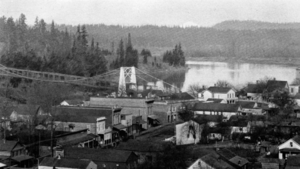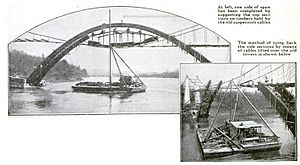Oregon City Bridge facts for kids
Quick facts for kids Oregon City Bridge |
|
|---|---|
 |
|
| Carries | |
| Crosses | Willamette River |
| Locale | Oregon City to West Linn, Oregon, United States |
| Maintained by | Oregon DOT |
| Characteristics | |
| Design | through arch of hollow box girder construction |
| Total length | 745 ft (227 m) |
| Longest span | 360 ft (110 m) |
| History | |
| Opened | December 28, 1922 |
|
Willamette River Bridge (No. 357)
|
|
| Lua error in Module:Location_map at line 420: attempt to index field 'wikibase' (a nil value). | |
| Location | Oregon City, Oregon; Willamette River at river mile 26.0 |
| Built | 1922 |
| Architect | Conde B. McCullough |
| NRHP reference No. | 05000639 |
| Added to NRHP | July 1, 2005 |
The Oregon City Bridge, also known as the Arch Bridge, is a strong steel bridge. It crosses the Willamette River between Oregon City and West Linn, Oregon, in the United States. This bridge is special because it's a "through arch bridge." This means the main road goes through a large arch structure.
The bridge was finished in 1922. It is so important that it is listed on the National Register of Historic Places. This list recognizes places that are important to American history. The Oregon Department of Transportation (ODOT) built and owns the bridge. It is part of Oregon Route 43.
The Oregon City Bridge is about 745 feet (227 meters) long. It is 28 feet (8.5 meters) wide. The main arch part is 360 feet (110 meters) long. It gives boats 49 feet (15 meters) of space under it when the river is low. Because the bridge is narrow, large trucks sometimes have to wait for other traffic to pass. Buses from TriMet (the local public transport) stopped using the bridge in 2009.
This bridge is unique because it's the only one in Oregon covered in a special concrete spray called "gunite." This coating protects the bridge from harmful gases from nearby paper mills. The bridge's designer, Conde McCullough, liked the concrete look. He added his special touches, like tall stone pillars, fancy railings, and Art Deco designs.
The Oregon City Bridge is located just below the 40-foot (12-meter) tall Willamette Falls. These falls are a natural waterfall. Nearby are the Willamette Falls Locks, which are the oldest boat locks in the United States. Another bridge, the George Abernethy Bridge, is downstream from here. It carries Interstate 205.
Contents
History of the Bridge
The Oregon City Bridge was built to replace an older bridge. The first bridge was a pedestrian (walking) cable-suspension bridge. It was finished in 1888.
Workers used the old bridge while building the new one. They used it to bring materials and workers to the site. It even helped support the new arch as they built it. Building the bridge was hard. The river was very deep, and there was a lot of boat traffic.
The new bridge opened on December 28, 1922. It cost about $300,000 to build.
Bridge Features and Changes
The bridge was designed with public restrooms inside its pillars. There were stairways on each side of the bridge deck that led down to these restrooms. However, people kept damaging the restrooms. So, they were closed in 1937. The stairway entrances were then covered with concrete.
The bridge also had windows for "observation balconies" at the top of the pillars. These were also sealed with concrete after the restrooms closed.
The bridge was added to the National Register of Historic Places on July 1, 2005. It was recognized as the "Willamette River (Oregon City) Bridge (No. 357)."
Weight Limits and Repairs
In March 2009, ODOT put new weight limits on the bridge. This happened after inspections showed damage to some of its support beams. Large trucks and vehicles weighing more than 14 tons were not allowed to use the bridge. This meant TriMet buses had to take a different route. They were rerouted to the Abernethy Bridge (I-205 bridge).
From 2010 to 2012, the Oregon City Bridge had major repairs. ODOT managed this project. Work started in July 2010. The bridge was completely closed to all traffic in January 2011. It reopened on October 15, 2012. The restoration project cost about $15 million. The last parts of the work were finished in early 2013.
ODOT said the goal was to make the bridge strong enough again. They wanted it to carry its original weight. This would allow TriMet buses to use it again. However, as of September 2013, TriMet buses had not returned to the bridge.
How the Bridge is Used Today
In the year 2000, about 12,800 vehicles crossed the bridge every day. This was only a 40% increase in traffic since 1953. Back then, people talked about building another bridge next to it.
The Oregon City Bridge never got a twin bridge. Instead, the George Abernethy Bridge (I-205 Bridge) opened in 1970. This new bridge became the main route for traffic in the area.
As mentioned, TriMet buses used the bridge until March 2009. That's when new weight limits stopped buses and heavy trucks from using it.
Images for kids
-
View from northeast, with Willamette Falls in background
-
Inside the bridge, with the bottom of the Oregon City Municipal Elevator visible












